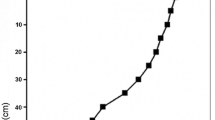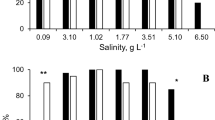Abstract
Two Daphnia clones were isolated from different day depths during the period of diel vertical migration and were tested for their life-history responses to a fish exudate released by juvenile perch. Animals were exposed to fish exudate every 24 or 48 h. Both clones responded to the exudate by exhibiting earlier maturation and larger sizes of first clutches, which resulted in higher rates of population increase. Also, neonates were smaller in the presence of the exudate. It was found that the clone isolated from a deeper day depth (‘migrating clone’) was less sensitive to the exudate than the clone isolated from the surface waters, which was presumed to be non-migrating. The non-migrating clone responded by having smaller neonate sizes and smaller sizes at maturity than the migrating clone. The non-migrating clone responded to the fish chemical when it was exposed to it every 24 or 48 h, whereas the migrating clone only responded to the exudate if exposed to it every 24 h.
Similar content being viewed by others
References
De Meester, L., 1993. Genotype, fish-mediated chemicals, and phototactic behaviour in Daphnia magna. Ecology 74: 1467–1474.
Gaillard, R. R. L., 1975. Culture of phytoplankton for feeding marine invertebrates. In Smith, W. L. & M. H. Chanley (eds), Culture of marine invertebrate animals. Plenum. New York: 29–60.
Lampert, W., 1989. The adaptive significance of diet vertical migration of zooplankton. Funct. Ecol. 3: 21–27.
Lampert, W., 1993. Ultimate causes of diel vertical migration of zooplankton: New evidence for the predator-avoidance hypothesis. Arch. Hydrobiol. Beih. 39: 37–44.
Loose, C. J., 1993. Daphnia diel verical migration behavior: Response to vertebrate predator abundance. Arch. Hydrobiol. Beih. Ergebn. Limnol. 39: 29–36.
Lüning, J., 1992. Phenotypic plasticity of Daphnia pulex in the presence of invertebrate predators: morphological and life history responses. Oecologia 92: 383–390.
Machácek, J., 1991. Indirect effect of planktivorous fish on the growth and reproduction of Daphnia galeata. Hydrobiologia 225 (Dev. Hydrobiol. 71): 193–197.
Meyer, J. S., C. G. Ingersoll, L. L. McDonald & M. S. Boyce, 1986. Estimating uncertainty in population growth rates: jackknife vs. bootstrap techniques. Ecology 67: 1156–1166.
Ringelberg, J., B. J. G. Flik, D. Lindenaar & K. Royackers, 1991. Diel vertical migration of Daphnia hyalina (sensu latiori) in Lake Maarsseveen: Part 2. Aspects of population dynamics. Arch. Hydrobiol. 122: 385–401.
Spaak, P. & J. R. Hoekstra, 1993. Clonal structure of the Daphnia population in Lake Maarsseveen: its implications for diel vertical migration. Arch. Hydrobiol. Beih. 39: 157–165.
Stich, H. B. & W. Lampert, 1984. Growth and reproduction of migrating and non-migrating Daphnia species under simulated food and temperature conditions of diurnal vertical migration. Oecologia 61: 192–196.
Tessier, A. J. & N. J. Consolatti, 1989. Variation in offspring size in Daphnia and consequences for individual fitness. Oikos 56: 269–276.
Weider, L. J., 1984. Spatial heterogeneity of Daphnia genotypes. Vertical migration and habitat partitioning. Limnol. Oceanogr. 29: 225–235.
Weider, L. J., 1985. Spatial and temporal genetic heterogeneity in a natural Daphnia population. J. Plankt. Res. 7: 101–123.
Weider, L. J. & J. Pijanowska, 1993. Plasticity of Daphnia life histories in response to chemical cues from predators. Oikos 67: 385–392.
Author information
Authors and Affiliations
Rights and permissions
About this article
Cite this article
Reede, T., Ringelberg, J. The influence of a fish exudate on two clones of the hybrid Daphnia galeata × hyalina . Hydrobiologia 307, 207–212 (1995). https://doi.org/10.1007/BF00032014
Issue Date:
DOI: https://doi.org/10.1007/BF00032014




